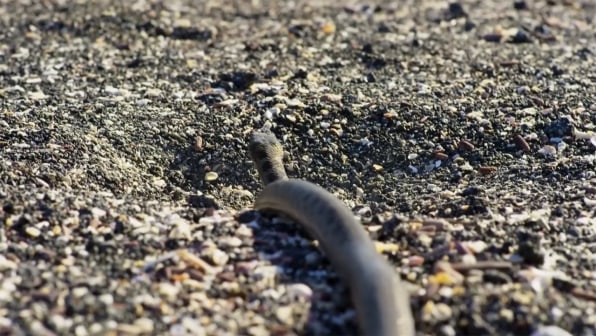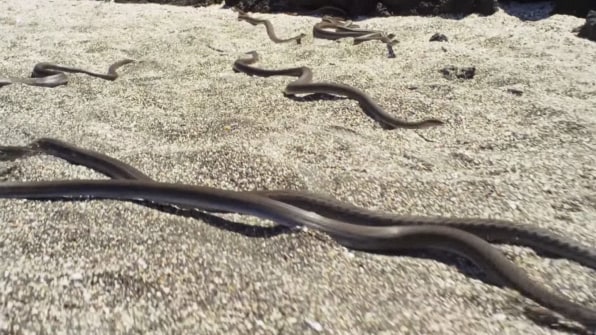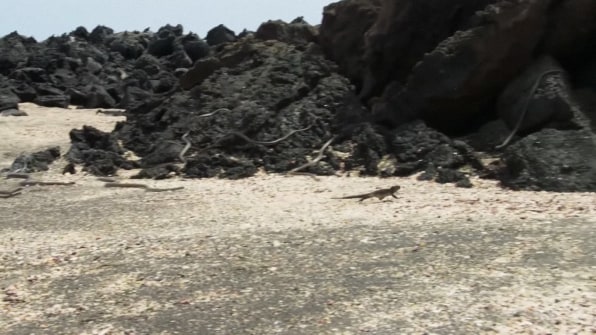Snakes Chasing Lizard Funny 100s of Snakes Chasing Lizard Funny
I never knew I could care so much about an iguana until I saw one running for its life with a swarm of snakes in hot pursuit in a clip from the nature documentary series Planet Earth II.
Produced by the BBC Natural History Unit, Planet Earth II is the follow-up to Planet Earth, which debuted in the U.S. 10 years ago. The premiere episode will be simulcast on BBC America, AMC and SundanceTV on February 18, then the series will air exclusively on BBC America for the next five Saturday nights.
As the well-circulated excerpt from the "Islands"-focused debut installment of the Planet Earth II begins (subsequent episodes focus on habitats, including cities, deserts, and jungles), a marine iguana sits on the beach on Fernandina Island, one of the unspoiled volcanic Galápagos Islands off the coast of Ecuador, when a racer snake slithers up from behind.
The iguana, a mere hatchling, instinctively stays still at first, hoping to elude detection, but when it becomes clear that the snake is going to strike, the iguana starts running, and racer snakes pour out of cracks in the rocks along the beach, joining the chase.
It is unnerving to watch, and it looks like the poor iguana is doomed when it gets tangled up in a bunch of snakes, but the reptile wriggles out of the cluster and scurries up the rocks, making a dramatic leap to safety as one snake lunges—its mouth wide open—in a failed last-ditch effort to catch its prey.

This victory is one to be savored, but just so you know, not every iguana in this episode is so lucky. This is a wildlife documentary series, after all, so someone has to be eaten.
Dr. Elizabeth White, a former research biologist and Planet Earth IIproducer who has worked for the BBC Natural History Unit for 13 years and produced the "Islands" episode, says that it wasn't easy for anyone on the crew to watch the scene portrayed in this clip—not to mention the other iguana/snake showdowns—unfold. "The fact that he made it up the rock safe was absolutely amazing," Dr. White says of the survivor. "We celebrated. Every time one got away we celebrated."
Well, it wasn't as simple as that.
"As a filmmaker, half of you wants the snakes to win," she admits, "and another half of you is like, 'I want this little one to get away!' You kind of feel like you get to know an animal even if you are just watching it through binoculars for a few minutes. Those iguanas, they're so young. They literally may have had just a few minutes experience of life, and they get caught, and that just seems brutal."

Narrated by Sir David Attenborough, Planet Earth II presents the animals as characters, and the snakes come across as the villains in this clip, which is edited like an action sequence from a Hollywood blockbuster with the iguana as the hero, but the snakes aren't motivated by malice, or greed, or a thirst for power, of course—they need to eat. "I feel sorry for the snakes because the island has so little food. So many of them were going hungry most of the time," Dr. White explains.
The marine iguanas of Fernandina Island are better fed because they venture into the ocean and dive for sea algae and seaweed. That said, some of their vulnerable hatchlings, who emerge from eggs buried in the sand and are small in stature but look pretty grown up and are ready to run, provide nourishment for other animals on the island, including hawks and snakes. Crabs even get in on the feasting, picking at the iguana skin left behind by other predators.
Out to depict how the food chain works on the remote island, Dr. White and the crew sought a location on Fernandina Island where they could find iguana hatchlings and show how one can make a meal for a ravenous snake or a hungry hawk.

They didn't expect to find so many snakes hunting a single iguana. It was just one of those times in wildlife filmmaking when a crew stumbles into an extraordinary situation.
Dr. White remembers the first time she witnessed such an encounter on the island. "One day, we were standing on the beach with binoculars looking for babies coming out of the sand, and we were watching when this little hatchling came out and ran towards this particular rock area, and literally this Medusa's head of snakes poured out of the rock and grabbed it," she says.
Not quite sure what they had seen, the crew moved in closer. "We looked at that area and started looking at the rocks, and we realized that one section of rock had a huge number of snakes," she says. "One crack in the rock wall would have eight to ten snakes in it."

So the filmmakers staked out that section of the beach, capturing some unique and dramatic wildlife footage.
In the interest of accuracy, snakes are not pack hunters, according to Dr. White. "They're not hunting in a pack. I really stress that. There is no pack hunting element. There is no coordination. That area of the beach just has a vast number of snakes, and if one snake gets a whiff that there might be food and starts to make a move, all the others follow," she says. "They're like, 'Whoa, what's that? What's he seeing? I want it, too.' "
Thankfully, for the crew members, including the cameraman who was closest to the action, tracking the iguana from three meters away with a small camera attached to a hand-held gimbal to keep the footage stable, the snakes of Fernandina Island had no interest in people. "They pay absolutely no attention whatsoever to human beings," Dr. White says. "I wouldn't have worn sandals, and I wouldn't have put a finger into those rock crevices, but there was absolutely no threat from those snakes to us."
Source: https://www.fastcompany.com/3068093/heres-the-story-behind-that-scary-iguana-vs-snakes-planet-earth-ii-clip
0 Response to "Snakes Chasing Lizard Funny 100s of Snakes Chasing Lizard Funny"
Post a Comment